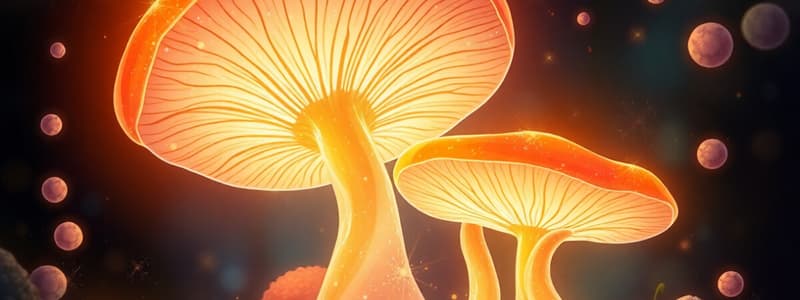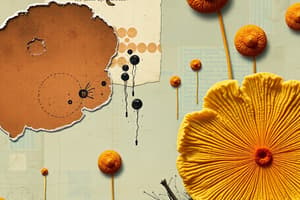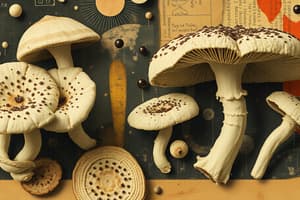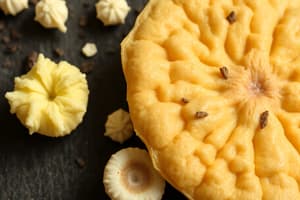Podcast
Questions and Answers
What type of cell do yeasts consist of?
What type of cell do yeasts consist of?
- Both unicellular and multicellular cells
- Eukaryotic cells (correct)
- Prokaryotic cells
- Multicellular cells
What is the primary reproductive method of yeasts?
What is the primary reproductive method of yeasts?
- Fragmentation
- Spores
- Budding (correct)
- Binary fission
Which characteristic distinguishes moulds from yeasts?
Which characteristic distinguishes moulds from yeasts?
- Moulds are eukaryotic.
- Moulds grow as multiple tubular branches. (correct)
- Moulds can exist in anaerobic conditions.
- Moulds are unicellular.
What environment is typically associated with moulds?
What environment is typically associated with moulds?
How do yeasts differ from moulds in terms of spore production?
How do yeasts differ from moulds in terms of spore production?
What is a typical color characteristic of yeasts?
What is a typical color characteristic of yeasts?
Which of the following health risks is associated with yeasts?
Which of the following health risks is associated with yeasts?
Which structure is formed by yeasts instead of true hyphae?
Which structure is formed by yeasts instead of true hyphae?
Flashcards are hidden until you start studying
Study Notes
Features of Fungi
- Fungi are eukaryotic organisms.
- Candida is an important fungus in dentistry.
- Fungi are found in two structural forms: yeast and mould.
- Some fungi can exist in both forms and are called dimorphic.
Yeast
- Yeasts are single-celled, unicellular organisms.
- They are found in various habitats, including fruit, mammal stomachs, oral cavities and vaginal areas.
- Yeasts are typically white and thready, appearing oval.
- Yeasts do not have true hyphae.
- Instead, they form multicellular pseudo-hyphae.
- Yeast is not a sporing species.
- Yeasts are less colourful than moulds, often appearing colourless.
- Yeasts can grow in aerobic (with oxygen) and anaerobic (without oxygen) conditions.
- Yeast can cause infections in individuals with weakened immune systems.
- Yeasts are often seen with lateral projections called daughter cells.
- Daughter cells split from the mother cell to produce the next generation through "budding".
- Some yeasts reproduce by binary fission.
- Yeasts can form pseudohyphae, which are chains of elongated budding cells.
- Candida forms pseudohyphae in the oral cavity.
Moulds
- Moulds consist of multiple, tubular branches.
- Moulds are multicellular organisms.
- Mould is typically found in damp, dark, or humid areas.
- Mould has a fluffy appearance and can be found in various shapes.
- Mould has microscopic filaments called hyphae.
- Mould is a sporing fungus.
- Moulds are colourful and can be orange, green, black, brown, pink, or purple.
Studying That Suits You
Use AI to generate personalized quizzes and flashcards to suit your learning preferences.




